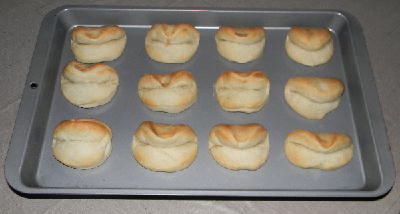

































| 3/4 c. buttermilk | 1/2 tsp. baking soda |
| opt. 6 tsp. salted butter, softened | 1/2 tsp. baking powder |
| 1 pkg. dry yeast | 1 tsp. iodized salt |
| 1/4 c. warm water for dry yeast | 4 T. granulated sugar |
| 2 1/4 c. all-purpose flour, sifted | 3 T. lard (or shortening) |
 Lard Substitution: Until the mid-1900s lard was commonly used in recipes but it was gradually replaced with Crisco® vegetable shortening.
Lard Substitution: Until the mid-1900s lard was commonly used in recipes but it was gradually replaced with Crisco® vegetable shortening.
